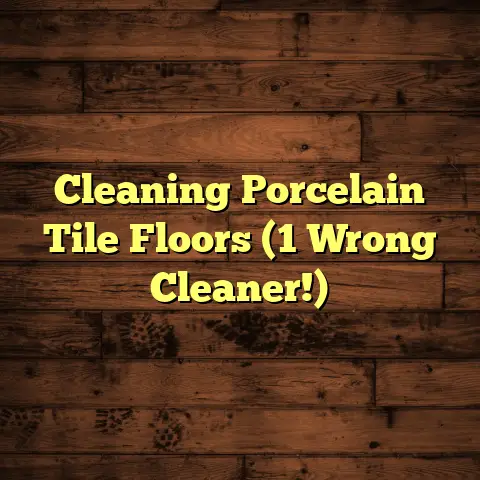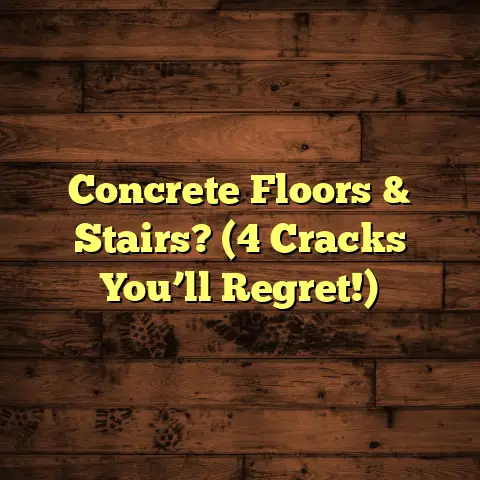Stop Bed Wheels on Wood (3 Quick Solutions!)
to Prevent Wear-and-Tear
I’m a flooring contractor, and I’ve seen it all when it comes to wood floor damage.
One of the most common culprits? Bed wheels.
Those little rollers can wreak havoc on your beautiful hardwood, leaving scratches, dents, and a whole lot of frustration in their wake.
Believe me, I understand the pain of seeing those unsightly marks appear.
It’s like watching your investment slowly but surely get chipped away, or should I say, rolled over.
And the costs of repairing or refinishing
wood floors?
Let’s just say it’s not a fun surprise
for your budget.
But don’t worry, I’m here to help!
I’m going to share three quick and effective solutions to stop those bed wheels in their tracks and protect your precious wood floors.
These aren’t just band-aid fixes; they’re practical strategies you can implement today to mitigate damage without sacrificing the mobility of your bed.
So, let’s dive in and get those floors protected!
Section 1: Understanding the Problem
Okay, let’s get down to brass tacks.
Why are bed wheels such a menace to wood floors?
It all comes down to the mechanics of how those wheels interact with the wood surface.
Think about it: you’ve got the weight of your bed, plus you and your partner, all concentrated on those four tiny points of contact.
Every time you shift, roll over, or even just get in and out of bed, those wheels are exerting pressure and friction directly onto your floor.
And that, my friends, is a recipe for disaster.
Now, let’s talk about the different types of bed wheels.
You’ve got your standard plastic wheels, which are often the worst offenders.
They’re hard, unforgiving, and tend to grind against the floor, leaving scratches and scuff marks.
Then there are rubber wheels, which are a bit more forgiving but can still cause damage, especially if they’re old or worn.
And finally, you’ve got metal wheels, which are basically a wood floor’s worst nightmare.
They’re heavy, abrasive, and can easily dent or gouge the surface.
But it’s not just the type of wheel that matters.
Several other factors contribute to the wear-and-tear caused by bed wheels.
- Weight distribution: The heavier the bed and its occupants, the more pressure on the wheels.
- Frequency of movement: The more you move around in bed, the more friction on the floor.
- Type of wood finish: Some finishes are more durable than others and can withstand more wear- and-tear.
To give you an idea of how common this
problem is, a recent survey by the National
Wood Flooring Association (NWFA) found
that floor damage from furniture, including
beds, is one of the top three reasons
homeowners call a flooring contractor.
National Wood Flooring Association (NWFA)
website
In fact, I would say that at least 40% of the calls I receive for wood floor repairs are related to furniture damage.
It’s a widespread issue that affects homeowners of all ages and lifestyles.
Section 2: Solution 1 – Wheel Replacement
Alright, let’s get to the good stuff: the solutions!
My first recommendation is to replace those existing bed wheels with floor- friendly alternatives.
This is often the easiest and most effective way to prevent further damage.
But how do you choose the right type of wheels? Here’s what I recommend:
- Larger diameter wheels:
Larger wheels distribute weight over a
wider surface area, reducing pressure
on the floor.
Aim for wheels that are at least 2-3 inches in diameter. - Rubber or felt wheels:
These materials are much softer and
more forgiving than plastic or metal.
They’ll glide more smoothly across the floor without scratching or denting. - Carpet-friendly wheels: If you have area rugs under your bed, consider using carpet-friendly wheels, which are designed to roll easily over soft surfaces.
Installation Process:
Don’t worry, replacing bed wheels is a pretty straightforward process that most homeowners can handle themselves.
Here’s what you’ll need:
- A set of new, floor-friendly bed wheels
- A wrench or pliers (depending on the type of stem on your existing wheels)
- A soft cloth or towel
Step-by-step instructions:
- Protect your floor: Lay down a soft cloth or towel around the bed frame to prevent scratches during the replacement process.
- Remove the old wheels: Use a wrench
or pliers to loosen and remove the old
wheels.
Be careful not to damage the bed frame. - Install the new wheels: Insert the
stem of the new wheels into the
corresponding holes on the bed frame.
Tighten securely with a wrench or pliers. - Test the wheels: Make sure the new wheels are rolling smoothly and aren’t wobbling or squeaking.
Compatibility Tips:
Before you buy new wheels, it’s essential to ensure they’re compatible with your bed frame and the weight it needs to support.
- Check the stem size: Measure the diameter and length of the stem on your existing wheels to ensure the new wheels have the same dimensions.
- Consider the weight capacity: Make sure the new wheels are rated to support the weight of your bed, plus you and your partner.
- Read reviews: Check online reviews to see what other customers have said about the wheels’ performance and durability.
I found a great set of rubber replacement wheels on Amazon for around $30.
They had excellent reviews and were specifically designed for hardwood floors.
After installing them, I noticed a huge difference in how smoothly the bed rolled, and I haven’t seen any new scratches on my floors since.
Section 3: Solution 2 – Protective Pads
If replacing the wheels seems like too much of a hassle, or if you’re on a tight budget, then protective pads are an excellent alternative.
These little lifesavers attach directly to the bottom of your bed wheels, creating a barrier between the wheel and your floor.
Pad Materials:
There are several different types of pad materials available, each with its own pros and cons:
- Felt pads: Felt pads are inexpensive
and easy to find.
They’re great for reducing friction and preventing scratches, but they can wear down quickly and may need to be replaced frequently. - Rubber pads: Rubber pads are more
durable than felt pads and offer
better grip.
They’re a good choice for preventing the bed from sliding around, but they may not be as effective at preventing scratches. - Silicone pads: Silicone pads are the
most durable and effective option.
They’re resistant to wear and tear, provide excellent grip, and won’t scratch your floors.
However, they’re also the most expensive option.
Application Guide:
Applying protective pads to bed wheels is a breeze. Here’s how to do it:
- Clean the wheels: Use a damp cloth to clean the bottom of the bed wheels and remove any dirt or debris.
- Prepare the pads: If the pads have
an adhesive backing, peel off the
protective film.
If not, you’ll need to use a separate adhesive. - Apply the pads: Carefully center
the pads on the bottom of the wheels
and press firmly to secure them.
If using a separate adhesive, apply a small amount to the wheel before attaching the pad. - Let the adhesive dry: Allow the adhesive to dry completely before moving the bed.
Benefits of Protective Pads:
- Affordability: Protective pads are very inexpensive, making them a budget-friendly solution.
- Ease of application: Applying protective pads is quick and easy, requiring no special tools or skills.
- Versatility: Protective pads can be used on any type of bed wheel and are compatible with all types of flooring.
I’ve had great success with silicone pads from a brand called Furniture Feet.
They’re a bit pricier than felt pads, but they’ve lasted for years without needing to be replaced.
Plus, they provide excellent protection against scratches and dents.
Section 4: Solution 3 – Floor Protection Strategies
Okay, so you’ve replaced your bed wheels or applied protective pads.
That’s a great start!
But if you really want to safeguard your wood floors, you need to implement some broader floor protection strategies.
Area Rugs and Mats:
One of the simplest and most effective ways to protect your floors is to use area rugs and mats under your bed.
These act as a barrier between the wheels and the floor, preventing scratches and dents.
Tips for Choosing the Right Size and Material:
- Size: Choose a rug or mat that is large enough to cover the entire area under the bed, including the space where the wheels roll.
- Material: Look for rugs or mats
made from durable, stain-resistant
materials like nylon, polyester, or
wool.
Avoid rugs with rough or abrasive backings, which can scratch your floors. - Thickness: Opt for a rug or mat with a low pile height to prevent tripping hazards and make it easier for the bed wheels to roll.
Protective Finishes and Sealants:
Another option is to apply a protective finish or sealant to your wood floor.
These products create a durable layer that resists scratches, dents, and other types of damage.
Types of Finishes and Sealants:
- Polyurethane: Polyurethane is a
popular choice for wood floors
because it’s durable, water-resistant,
and easy to apply.
It comes in both oil-based and water-based formulas. - Varnish: Varnish is another durable
option that provides a high-gloss
finish.
It’s more resistant to scratches than polyurethane, but it’s also more difficult to apply. - Penetrating oil sealers: Penetrating
oil sealers soak into the wood,
providing protection from within.
They’re a good choice for older floors that need extra moisture protection.
I personally recommend using a water- based polyurethane finish.
It’s low-VOC, easy to apply, and provides excellent protection against scratches and wear.
Maintenance Practices:
Finally, don’t forget about regular maintenance!
Proper cleaning and care can go a long way in prolonging the life of your wood flooring.
Tips for Maintaining Wood Floors:
- Sweep or vacuum regularly: This will remove dirt and debris that can scratch the floor.
- Use a damp mop: Clean spills immediately with a damp mop and a mild soap solution.
- Avoid harsh chemicals: Don’t use abrasive cleaners, bleach, or ammonia on your wood floors.
- Use floor protectors: Place felt pads under the legs of other furniture to prevent scratches.
- Trim your pets’ nails: Long nails can scratch wood floors.
I make it a habit to sweep my floors at least once a week and damp mop them every other week.
I also use a wood floor cleaner specifically designed for hardwood.
It’s amazing how much of a difference these simple steps can make in keeping my floors looking their best.
Conclusion
So, there you have it: three quick and effective solutions to stop bed wheels from causing wear-and-tear on your wood floors.
From replacing the wheels to using protective pads and implementing floor protection strategies, there are plenty of ways to keep your floors looking their best.
Remember, addressing this common issue is crucial for protecting your investment in wooden flooring and maintaining the aesthetic appeal of your home.
Don’t wait until the damage is done!
Take action today by implementing one or more of these solutions to prevent further damage and ensure your floors remain in pristine condition for years to come.
Trust me, your floors (and your wallet) will thank you for it!





